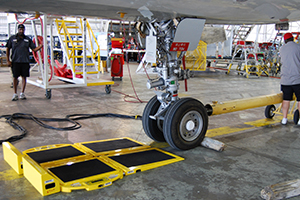Training Desk Notes (6/6): Weighing Procedures
Category: Aviation
February 2, 2021
Earlier in this series, the necessary steps to prepare aircraft and equipment prior to a weighing were addressed. Up to this point, the aircraft has been properly defueled and configured for its weight and CG check.Prior to writing any numbers down, there is a list of items one must check before the aircraft is weighed. First, make sure there is no wind influence on our aircraft when it is on the scales/load cells. Hangar doors and windows should be closed, the air conditioning or heating should be off, and there should be no fans blowing on or near the aircraft. One must verify the scales are within their calibration dates. Intercomp scales are capable of integrated automatic Latitude and Altitude corrections, but if your scales do not have that ability, then one must annotate the Lat/Alt correction and apply it to the total weight. Whether using platform scales or top of jack load cells, exercising the scales with the full weight of the aircraft is advisable.
If using additional jack pads to protect the airframe jack point with Top of Jack/Axle Jack, their weight and moment (weight times the arm) must be recorded in order to delete them from the total weight and moment shown on the scales. To eliminate any side loading, aircraft jacking must be done as level as possible. Do not be in a hurry in either lifting or lowering; down jacking also should be done slowly and as level as possible for safety. Remember to exercise the load cells to the full weight of the aircraft and then zero your scales prior to the first actual weigh.
When using platform scales, a tow vehicle is the preferred method of getting the aircraft up onto your scales, which is much safer than pushing the aircraft. Once the scales are exercised to the full weight of the aircraft, zero your scales prior to your first actual weigh. If you feel you need to chock your aircraft once up on your scales, place the chocks on the scales first and then re-zero your scales. This makes your chocks invisible to the weight shown (and yes, once the chocks are removed you will display a negative number, which is to be expected).
Now just a bit of math to determine your total weight and moment…then calculate your center of gravity. Software or apps are available to record the information, perform the calculations, and output the data for these platform scale and jack weighing techniques.
Attachments:



